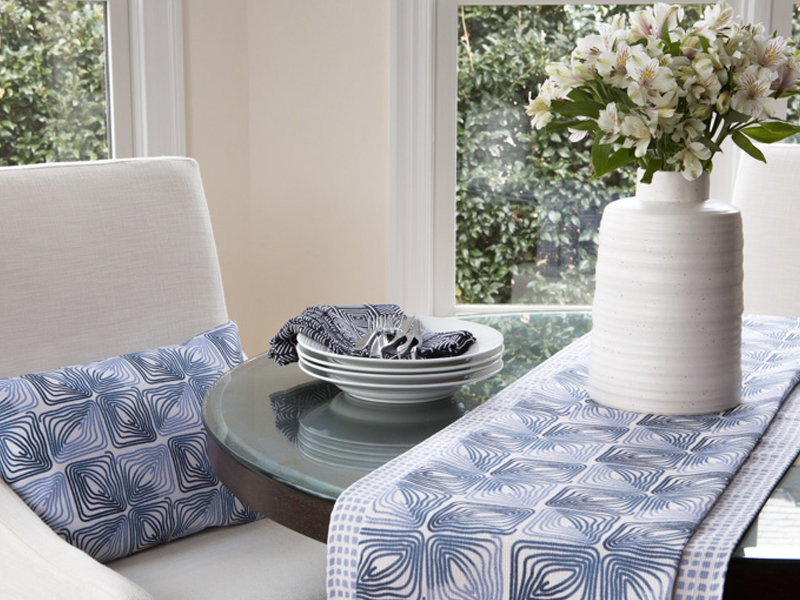An empty tabletop is like a blank canvas. You’ve got a good, solid base layer – wood, slate, or otherwise – that is longing for personality and color. Add a bit of magic to any meal by layering on table linens alongside your dishes and flatware.
We’re here to help you pick the right fabrics for your perfect tabletop look. Let’s start with the most basic table necessity, napkins.
Napkins
When shopping for napkin fabrics, look for materials that are both machine washable and soft. This is an item you will be using on your face – a scratchy fabric will not do. If you’re looking for custom printed napkins, try our Mini Herringbone, Textured Basic, or Twill fabrics. They’re both soft and washable!

Mumba Cross by artist monicaguerro on our Textured Basic fabric.
If you’re planning to sew your own napkins, consider using a technique like a rolled hem or a mitered corner. These techniques create a polished, elegant look. Lisa over at Celebrate Creativity has a fabulous mitering tutorial over on her blog. As Lisa says, if you can sew a straight line, you can miter a fabric corner.
Placemats
Placemats can dress up the most casual of meals. They also help keep your table clean and neat, no matter how many messy eaters you have.
There are two considerations when picking fabrics for placemats: machine washability and weight. By picking a heavier weight fabric, you don’t need to add backing or batting to your placemats. This makes the sewing process simpler and cheaper. If you’re sourcing from WeaveUp, our Duck, Mini Herringbone, and Satin Chenille fabrics are superb picks.
There are a ton of placemat tutorials out there. We especially love the utility of reversible placemats – two placemats in one! This tutorial from Creative in Chicago shows just how easy it is to sew reversible placemats.
Table Runner
Runners add a focal point to your table decor, but they serve a secondary function as well. Runners protect your tabletop from the heat and scratches of serving dishes. Because runners are not as likely to get spilled on as placemats or napkins, you can opt for a dry-clean fabric. Our Sparkle Chenille fabric is especially fun for holiday dinner decor.
Runners can float in the center of the table, leaving room for placemats on all sides. More traditionally, they can run the full length of the table and drop over the edge. They can be used with or without a tablecloth, and layering a narrower runner on top of a wider one is a great way to mix prints.
Runners are sewn using the same technique for placemats – measure your table and adjust the dimensions accordingly.
Tablecloth
Not only can a tablecloth can take your dinner decor to the next level, it also protects your table.

Designs shown are Botanical Garden 2, Rattle Box 5, Philips Chevron
The first step to choosing a tablecloth is to measure your table and determine how much overhang you want. Overhang is the fabric that drapes over the edge of the table.
- For a casual look, a 6″ – 10″ overhang on all sides is appropriate
- For a dressy look, a 15″ overhang on all sides is appropriate
- For a dramatic, formal look, a floor length tablecloth is appropriate
Your total tablecloth measurements equal the dimensions of your table plus your desired overhang. Add the desired overhang to all four sides of your table dimensions.
Next up, decide what shape of tablecloth is right for you. Do you have a square, rectangular, or circular table? In any case, if your tablecloth measurements are wider than 54″, you will have to sew two fabric panels together. There are a couple of ways to do this.

For a round tablecloth, sew three panels together so the seams sit on the sides of the table. A square tablecloth can also work for a round table where only 4 people will be seated.

There are two ways to sew a rectangular tablecloth, shown above. If you are not planning on using a table runner, sew a wide panel in the center of your tablecloth with two narrower panels on either side. Keep these smaller panels the same size – symmetry is king!
If you are planning on using a runner, you can sew the two panels down the center of the tablecloth – the runner will cover your seam.
When picking a fabric for your tablecloth, look for something that has a great drape that is easy to wash. WeaveUp has many great fabrics suitable for tablecloths – Mini Herringbone, Duck, Sateen, Taffeta Slub, Satin Chenille, Twill, Plain Weave, and Textured Basic being a few.
Head over to our Fabric Guide to learn more about all our fabrics. If you’re ready to start shopping, our Design Library has over 12,000 designs to choose from!



Leave A Comment